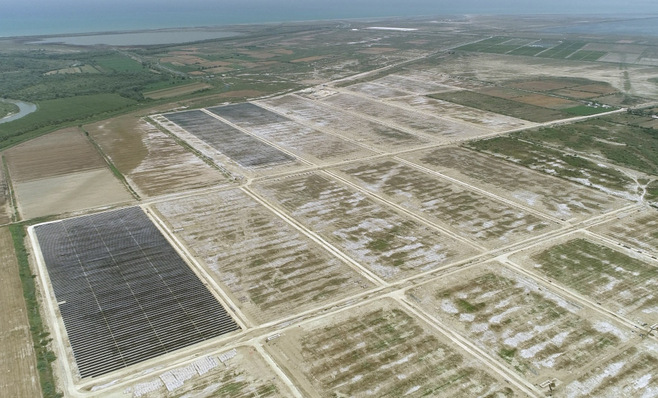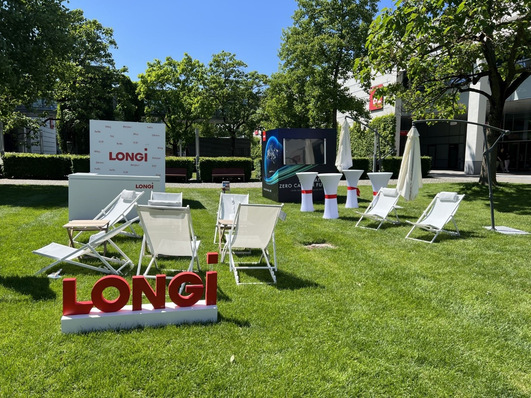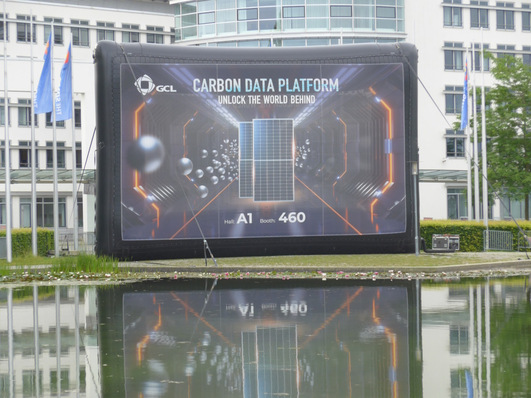So far, the topics agro-photovoltaics and module cooling have led a niche existence. Most companies are distancing themselves from these topics in advance. Due to the verly low module prices, solar cooling is considered completely uneconomical.
This is true wherever it concerns salt storage tanks or cooling coils that are glued behind each individual module. Spray systems are an exception, but with their high consumption of drinking water in the drought-plagued sun belt, they disqualify themselves.
However, if a holistic approach is taken and desalination is combined with solar cooling and agriculture, the profitability of a solar project can be doubled. Using a very inexpensive yet highly effective evaporator material, we can use salted water to produce many millions of cubic metres of salt-free cold humid air.
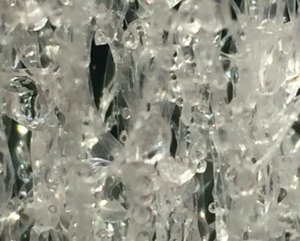
With this air, special agro-photovoltaic greenhouse solar power plants can be cooled contact-free on the back of the modules. Apart from the elevated installation in the form of a gable, no modifications to the power plant are necessary and the modules are only cooled by the cold air flow at the back. The humidity cannot harm the modules, as they are constantly heated by the sun and the dew point is therefore not reached.
Cheap cooling technology
The efficiency of this cooling is only a very modest 30%. However, this is no problem due to the massive overcompensation of the very cheap cooling technology. Because the unused cooling is not lost, but instead benefits the agriculture under and behind the solar plant. At temperatures of up to 50 degrees Celsius and low humidity, this is absolutely necessary and, in extreme cases, can even prevent a total failure of the cultivation.
Enclosed are the calculation results for a location in India in the region of Haryana northwest of Neu Deli where many farmers within a radius of 150 km are now totally impoverished due to salinated ground water. Here, many farms could be operated profitably again with such power plants. The necessary investments should come from the solar investor, who would receive a share of the profits from the increased agricultural yields.
| ROI in years | 0.5 MW | 5 MW | 50 MW |
| Classic solar | 11,63 | 9,23 | 7,59 |
| Agro-PV + IrrigationNets | 8,09 | 3,82 | 2,32 |
The strong improvement in the economic efficiency of larger plants results from the much larger area supplied, since a wider air flow can also supply a much larger area.
The location in India is ideal for the IrrigationNets system, because of the low humidity and extremely high temperatures. With this we can generate up to 20°C colder air with 99% humidity. Thus, the positive effects of saltwater evaporation cooling are the strongest and show the greatest benefit here.
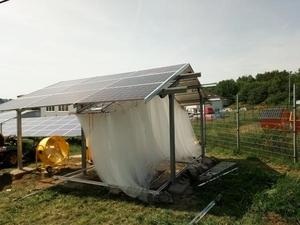
Similar ideal conditions can be found in the Algerian desert, in the north of Kenya, in South Africa, in Jordan, in the north of Paraguay and Chile. In these countries we find very large saline groundwater deposits, which are currently not being used in an economically viable way. In addition, we are located in the middle of the interior of the country and due to the continental climate we have an extremely low humidity, which increases the efficiency of the IrrigationNets system.
However, the system should also pay off on more than 200,000 km of coastline in over 40 other dry countries. These include Spain, Italy, Portugal and Greece. Even in Germany, we find two rivers with now salty water due to the Elbe Deepening. The area is called: "The Old Country" and is famous for apple plantations.
Did you miss that? Drinking water for the Maasai
Plantations which can no longer irrigate. Also here saltwater cooled solar power plants can help the plantations by cooling and additional humidity. Fruit plantations have long been equipped with drinking water spray systems for cooling the environment. However, these spraying systems can only be used in the early hours of the morning, as otherwise water droplets can cause skin burst at the fruits when the sun shines strongly. A solar power plant that continues to produce cold, humid air even at the hottest time of the day can greatly improve fruit cultivation. This is because this moisture is completely dissolved in the air and does not lead to droplet formation on the fruit.

The interlinking of solar projects with agriculture therefore opens up many interesting synergies, which more than compensate the additional costs. In net terms (after subtracting the energy for pumps and ventilators) about 10 percent more additional energy can be generated for sales. The modules also have up to 30 percent longer service life due to cooling.(VK/HCN)





